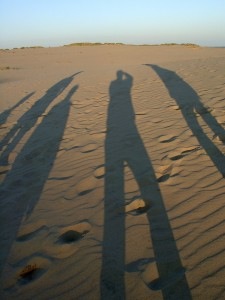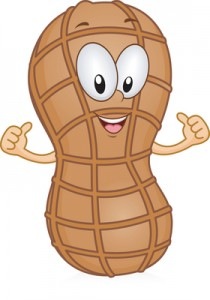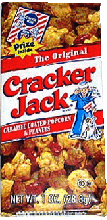The more you eat, the less flavor; the less you eat, the more flavor. ~ Chinese Proverb
 The power is out all over town. Hurricane Irene has downed power lines up and down the East Coast and I’m sure many of you are wondering what to do with all that food in your fridge and freezer.
The power is out all over town. Hurricane Irene has downed power lines up and down the East Coast and I’m sure many of you are wondering what to do with all that food in your fridge and freezer.
From numerous past experiences I know that one of the challenges in the aftermath of a power failure is figuring out what to do with the food in the fridge and freezer.
If you cooked up a storm right before the actual storm (or whatever caused the power failure), according to the March 2010 edition of the Nutrition Action Healthletter (Center for Science in the Public Interest), you should follow these general rules:
The following food safety information is from the CDC:
According to the USDA: “food may be safely refrozen if the food still contains ice crystals or is at 40 °F or below. You will have to evaluate each item separately. Be sure to discard any items in either the freezer or the refrigerator that have come into contact with raw meat juices. Partial thawing and refreezing may reduce the quality of some food, but the food will remain safe to eat. See the attached charts for specific recommendations.”
According to the USDA follow these guidelines for what can be kept or should be thrown out: “Do not eat any food that may have come into contact with flood water. Discard any food that is not in a waterproof container if there is any chance that it has come into contact with flood water. Food containers that are not waterproof include those with screw-caps, snap lids, pull tops, and crimped caps. Also, discard cardboard juice/milk/baby formula boxes and home canned foods if they have come in contact with flood water, because they cannot be effectively cleaned and sanitized.”
For more specific information please visit this USDA site.
 Everyone eats food. It’s a source of comfort, love, nourishment – and at times, pain, bribery, control, and reward. Many of us remember and associate the food we ate, where we ate it, and with whom with good – and bad – events.
Everyone eats food. It’s a source of comfort, love, nourishment – and at times, pain, bribery, control, and reward. Many of us remember and associate the food we ate, where we ate it, and with whom with good – and bad – events.
People can love food but be traumatized by it, too. Food can be used as control in prisoner, famine, or hostage conditions. People with eating challenges become so traumatized by food that it is seen as the enemy rather than nourishment. Soldiers and captives associate certain foods with the enemy and often will never eat that food again.
Food has always played a major role in my large Greek/Russian restaurant family. We have big get-togethers and a whole lot of food. After many of us traveled, certain beloved food and wine from other cultures became incorporated into our family menus.
Recently – and sadly — food played a front and center role for my family acting as a rubber band, band-aid, and a source of comfort and nourishment.
My Mother-in-law, Arla, died suddenly last week. She was two weeks shy of her 87th birthday, seemingly in good health, active, and involved. Eating out was her passion and a defining part of her life. Fittingly, the last time I saw her, four days before her death, she had had lunch at Nobu with her friends and had invited her grand-daughter-in-law and her great-grandson, Jack, who is lovingly named after her husband. She followed this by dinner on the same day with my husband and me at a well-known Upper West Side restaurant. When we arrived, she was waiting for us at the bar and during dinner, as she usually did, she critiqued the menu, food, décor – and the wine.
Exactly one week later, food and drink played a major role the night before her memorial service. Immediate family, having arrived by car, plane, and train gathered at a restaurant (which she would have approved of) to eat, drink, and reminisce. It was a much needed opportunity for communal sharing – with animated commentary on the choice of wine – none of which my Mother-in-law would have drunk having preferred dry, cold white wine that made your mouth pucker.
After the memorial service there was an open house at my apartment. Fittingly, food and drink provided a focus, nourishment, and conversation starter. Even the caterer – who had become Arla’s friend, generously made a gift of the food in her honor. Prompted by salami, cheese, fruit, cookies, coffee, wine, soda, and sparkling water, everyone seemed to have a story to tell that related to special food – or drinks – or restaurants – or trips — and Arla.
Our family always joked that she kept cans of soda in her apartment for years and years that ended up being off-tasting and flat. I’ll be darned if the first bottle of Coke, opened by her nephew and purchased two days before, wasn’t flat. Was she smiling?
Her brother suggested we serve only American red wine knowing she wouldn’t have drunk it – didn’t this make him feel better and lighten the mood?
Her good friend, an actress, went straight to the coffee pot. Even though it was close to 1PM she needed her morning coffee – she’s usually just getting up at that hour. Wouldn’t Arla, who was always up at the crack of dawn, coffee in hand, have smiled?
People ate, people drank, and people told stories. Little kids and babies ate. The dog scarfed up crumbs. My oldest son shared some jellybeans with his brothers and cousins that he took from his grandmother’s ever present and always full jellybean bowl on the day she died. “Fresh ones,” he said, “she must have just filled it up.”
The communal spirit – initiated by the unexpected passing of a mother, sister, mother-in-law, grandmother, great-grandmother, aunt, sister-in-law, and dear friend – was aided and supported through the comfort and familiarity of food and drink.
On the way to my apartment after the service I was in a cab with one of my sons and Arla’s brother. As the cab alternately rocketed and crawled down Ninth Avenue we passed one of my favorite food stores in Manhattan – Poseidon Bakery. Their spanakopites (spinach pies) and tiropites (cheese pies) have graced many a family event. I commented on this is we passed the store. “Maybe we should stop,” I said, mostly in jest. My son smiled and her brother Steve cackled and turned with a certain look in his eye. Arla would have loved it.
 It’s not stretch of hot white sand. It’s also not where you can come upon an oasis, shimmering in the heat, and find platters laden with fresh fruit like in old-time movies.
It’s not stretch of hot white sand. It’s also not where you can come upon an oasis, shimmering in the heat, and find platters laden with fresh fruit like in old-time movies.
Here’s what it is: the CDC defines a food desert as an area “that lack(s) access to affordable fruits, vegetables, whole grains, low-fat milk, and other foods that make up the full range of a healthy diet.”
It would seem pretty obvious that if there isn’t a readily available supply of good food for people to buy and eat then they won’t eat healthy food.
But here’s the problem: many food deserts may not have a lot of affordable healthy food choices available, but they may have readily available and inexpensive fast food choices.
The CDC indicates that some researchers think a link exists between having easy access to affordable healthy foods and the consumption of those foods. But other studies show that even when healthier food options are available in food deserts, many people continue to make unhealthy choices based on their own personal preferences — or put more simply — because they want to.
A study of 5,115 people, just published in The Archives of Internal Medicine, looked at fast food and fruit and vegetable consumption compared to the availability of fast food restaurants and groceries. The researchers found that in “food deserts,” where fast food is readily available and there are few or no supermarkets, the local population is drawn to the fast food. But even where there are supermarkets and groceries the food choices the locals make don’t seem to be based on healthy eating.
The results showed that in low-income areas, particularly among men living within one to two miles of a fast food restaurant, there’s a strong association between the availability of fast food and how much of it they consumed. But, they also found that there was no strong association between living near a supermarket and eating more fruits or vegetables.
The lead researcher says that it isn’t enough to expect that building supermarkets will make people shop for healthy foods in them. She thinks that healthy foods need to be promoted and affordable and that people also need to be taught that there are better and healthier food choices available in fast food restaurants, too. If someone chooses to go to a fast food restaurant they should have the option to find and choose food items that are “relatively more healthy as opposed to less healthy.”
However, just because there might not be a strong association between food choices and supermarkets doesn’t mean that markets aren’t important. It might be that the market may not be stocked with an abundance of healthy food choices or that the healthier options are expensive and crowded out by an overwhelming array of unhealthier options.
It’s not enough to just teach people what’s healthy and how to make healthy choices. The food environment is crucial and needs to support making healthy food choices easy, attractive, affordable (competitive with the “cheap” calories of fast food), and the cool choices to make. Just like the oasis in the sandy dessert, there needs to be a welcoming oasis of healthy food choices in the “food deserts.”
 Happy Summer! Baseball season is in full swing and so are visits to amusement parks. What do you usually do at these places – other than watch the game, ride the roller coaster? EAT, of course!
Happy Summer! Baseball season is in full swing and so are visits to amusement parks. What do you usually do at these places – other than watch the game, ride the roller coaster? EAT, of course!
Oh, the food! Oh the calories! Hang on – this post is not about ignoring the good time food. Of course, there are always healthy food options: you can bring your own or be scrupulous in making healthy choices. But honestly, do you think that most people really want to eat low calorie foods when they’re at a ballgame or amusement park? No way.
So what do you do when you’re at these places with food vendors about every 20 feet hawking dogs, ice cream, and beer?
If you’ve got a will of iron, I guess you could ignore the food and drinks. But if you’re like most people and you’re tempted at every turn, you can try to minimize the damage without taking out the fun. If you know you’re going to be having a stadium or food court meal, do some thinking, planning, and learning. The best choices are not always the obvious ones.
Do you need both peanuts and popcorn? Can you make do with a regular hot dog instead of a foot-long? Can you keep it to one or two beers instead of three? Can you choose the small popcorn instead of the jumbo tub?
Here’s some info to help you make your best choice. Just a heads up – we’re not talking about the most nutritious choice because given these foods, quality nutrition is not front and center. You can, however, enjoy your day and make the best caloric choice (with a nod to fat and sugar content) and still eat traditional ballpark and amusement park food.
 Cracker Jack (officially cracker jack, not jacks): candy-coated popcorn with some peanuts. A 3.5oz stadium size box has 420 calories but does have 7g protein and 3.5g fiber.
Cracker Jack (officially cracker jack, not jacks): candy-coated popcorn with some peanuts. A 3.5oz stadium size box has 420 calories but does have 7g protein and 3.5g fiber.Sources:
http://www.fatsecret.com/calories-nutrition
http://www.active.com/nutrition/
http://www.drweigh.com/blog/